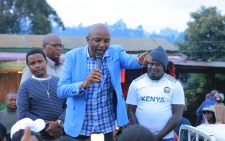Grade 4 evaluation was fair, says Knec

The government has defended the results of the Grade Four assessment released early this year.
The Kenya National Examinations Council (Knec) chief executive David Njeng’ere said the scores that learners got are a true reflection of their respective capacities.
He said Knec would only come in to check when it feels there is a skew in grading because even within criterion referenced system, there will still be a curve since all learners cannot perform the same.
“The challenge of some teachers being tempted to massage the numbers is there and that is why Knec exists to make sure that when those tendencies arise, we have a mechanism of stepping in,” said Njeng’ere, during a media stakeholders forum organised by Kenya Institute of Curriculum Development (KICD).
He explained that the Teachers Service Commission (TSC), Knec and KICD has been gradually training teachers on implementation of Competency Based Assessment (CBA) and are competent to do the job satisfactorily.
“There is need for us to trust our teachers. It is true that the temptations might be there but teachers should be trusted and you know, sometimes it is the parents who put pressure on teachers so let us try not to demonise teachers,” said Njeng’ere.
He said the 40 per cent score at the end of Grade 6 will be used to help with selection as learners move to the next level but the 60 per cent will be purely criterion referenced thus Knec must find a middle ground.
The 60 per cent scores of the final mark to transit to junior secondary will be obtained across Grades 4, 5 and 6 respectively, with each contributing 20 per cent.
“We had to create a hybrid between norm referenced and criteria referenced scoring so that the 60 per cent is purely criterion referenced and that is why no one is coming to moderate, it is teachers who give the curve,” he explained.
Assessment tools
He also said that assessment tools will not be recycled. “Assessment tools are not the same, for instance we have done two years for Grade Three and the tools to be used this year are different from the ones used in 2019 and last year, they will be getting fresh tools every year from Knec,” he said.
He said Junior Secondary is general and has a broad curriculum to allow children test their abilities in different areas so that they are given a chance, without the fear of an exam coming, to try what they are good in.
“They have been given three years to test themselves in all areas so that at the end of Grade 9, the learners, the school and parent will be able to tell where the children are inclined,” he said.
Since there are no pathways in Junior Secondary School, Njeng’ere said that maybe the challenge of ‘massaging grades’ will be cured once the first cohort gets to Senior Secondary School.
“It will be obvious that grades were massaged earlier on if learners end up in Senior Secondary School in a track that is offering say pure science.
If grades were massaged earlier and in the class they are all doing pure sciences, wouldn’t it be obvious that a learner does not belong there?
So within a short time, this will start to cure itself because it happened with malpractices of KCSE and university,” explained Njeng’ere.
Digital literacy
At the same time, the Knec CEO said CBC learners will exit school with seven core competencies, which include digital literacy.
“My view is that you cannot suspend such a critical competence. When we say that we will do away with it completely until everyone has access, what will be the effect on those children?
In my opinion, those children we are pointing out and saying that they cannot access are the ones who need it most because they will remain behind compared to those who can access it,” he explained.
He said digital literacy can still be achieved because all public primary schools, with just a few exceptions, have devices.
“The government has provided devices, which have capacity to take photos, can record and store so children do not have to be made to do things at home.
They can take the photos with the devices at school and use them there. Schools also have LCD projectors supplied by government,” he said.
He added: “Every public primary school has a storage device of two terabyte, which can take a long time to fill.”











